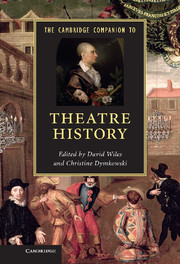2 - Modernist theatre
from Part II - When?
Published online by Cambridge University Press: 05 February 2013
Summary
From the perspective of Western culture, ‘modernity’ can be summed up as an era that began in around 1500, shaped by the emergence of capitalism, industrialisation, secularisation and rationalism. By contrast, ‘modernism’ is characterised by developments during the transition from the nineteenth to the twentieth century in the sphere of culture, which correlate with political and social upheavals, technological innovation and aesthetic experimentation. The terms ‘modernity’ and ‘modernism’ are the subject of controversies striking at the very self-image of Western culture. This debate is made ever more complex when seen through the lens of the twenty-first century within a globalised world: the modern age? post-modern? Were we ever ‘modern’?
In academic discussions, the terms ‘modern theatre’ and ‘modernist theatre’ entail a difference of focus in respect of timescale and subject matter. However, the language of theatre history is often inconsistent. For instance, in The Oxford Illustrated History of Theatre, John Russell Brown divides the period since 1500 into two sections: ‘From the Renaissance to 1700’ and ‘European and Western Theatres from 1700’. The notion of modernity does not come into play, though it could have served as a pointer to the influence of capitalism, industrialisation, secularisation and rationalism upon theatre since 1500. The time-span between 1500 and 1700 is split into four chapters based on national criteria (Italy, Spain, England, France), whereas the span between 1700 and 1970 fills four chronologically organised chapters that include ‘Eighteenth-Century Theatre’ and ‘Nineteenth-Century Theatre’ before ‘Modern Theatre: 1890–1920’ comes to be investigated. The mismatch here between a strictly limited time-frame and the expansive adjective ‘modern’ is striking. This chapter by Martin Esslin covers what is normally regarded as ‘modernist’ theatre, namely Naturalism and the movements that distinguished themselves from it: Symbolism, Futurism, Expressionism, etc. We see that theatre historiography tends not to discuss under the sign of ‘modern’ the longue durée, which is to say the long time-span of theatre’s evolution since 1500, but tends rather to trace developments in smaller segments. If it does not differentiate between ‘modern theatre’ and ‘modernist theatre’, this is perhaps because our everyday language fails to do so, using ‘modern’ essentially as a relational concept setting a boundary to what constitutes the present. Or perhaps theatre historiography fails to address modernity because it has decided to take as its subject matter the opposition between Naturalism and Anti-Naturalism that theatre practitioners like to describe as ‘modern’.
- Type
- Chapter
- Information
- The Cambridge Companion to Theatre History , pp. 15 - 32Publisher: Cambridge University PressPrint publication year: 2012
References
- 2
- Cited by

